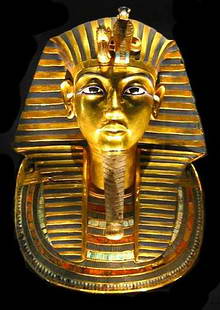|
| ||||||
|
| |||||||
|
| |||||||
|
Texana:
Texas Book Reviews Reviews of Texas General, Texana, Texas wine books and Guides Cookbook Reviews All our reviews of cookbooks News Stories Stories on major events, people and culture Notable Native Texans The famous and infamous born in Texas Texas Sports Store Clothing for UT, Texas A&M and Texas Tech
Free Newsletter
Register to receive our free monthly Texana newsletter Message Boards Ask questions, discussions
Visit & Bookmark:
Texas Cooking www.texascooking.com Recipes, food articles, barbecue, chili, desserts |
 Golden Boy: Tut's Treasures in Dallas
by Lori Grossman When Egyptian officials were deciding which American cities would host the encore tour of "Tutankhamun and the Golden Age of the Pharaohs," Dallas had an unexpected ally - Pharaoh Ramses the Great. In 1989, Dallas hosted a Ramses II exhibition at Fair Park, a National Historic Landmark, and home of the State Fair of Texas. The Egyptian antiquities generated enormous interest and drew large crowds. Eighteen years later, Zahi Hawass, Secretary General of the Supreme Council of Antiquities in Cairo, remembered the exhibit's popularity and arranged for the Tutankhamun artifacts to come to the Dallas Museum of Art. It's the first time that treasures from the young king's tomb will be displayed in the Southwest. Tutankhamun's life and early death have been the subject of worldwide fascination ever since the discovery of his tomb in 1922. Only a young boy when he came to the throne around 1337 B.C., Tutankhamun took over a country going through a period of great unrest. Ancient Egypt was a polytheistic society. The boy king's predecessor, Akhenaten, had elevated the sun god, Aten, to chief god of state, replacing Amun, the god representing the unseen powers of the cosmos. The Egyptian people resented the change. The religious revolution was the biggest crisis of Tutankhamun's short reign. Soon after he came to power, he brought back Amun as the universal god of Egypt. Also, he changed his birth name - Tutankhaten - to the name familiar to history, Tutankhamun (living image of Amun). Tragically, he died in January 1327 B.C., when he was only about 18 years old. His death has been the cause of speculation for years.
The Valley of the Kings, on the west bank of the Nile across from present-day Luxor, served as the final resting place for most of the pharaohs. Over the last five thousand years, tomb robbers have broken into and looted many of the tombs. Europeans began searching for royal burial sites in the early 1700s. Howard Carter, with financial backing from a wealthy British aristocrat, Lord Carnarvon, began his search for Tutankhamun in 1917. It took five years to find the biggest prize of all. Carter found Tutankhamun's tomb in November 1922. On the 26th, he lit a candle and peered through a hole in a plastered doorway. This is how he described the incredible sight: "At first I could see nothing, . . . but presently as my eyes grew accustomed to the light, details of the room within emerged slowly from the mist. Strange animals, statues, and gold, everywhere the glint of gold." Over the next 10 years, more than five thousand artifacts were discovered, preserved, and recorded. Fifty of the extraordinary objects in the DMA exhibit belonged to Tutankhamun. One artifact in particular serves as a poignant reminder of how young this boy was when he became pharaoh - an ingeniously designed child-sized chair. Ebony and ivory strips form the intricate design on the curved chair back. The armrest panels are covered with gold foil and embossed with nature scenes. The legs are cleverly designed to resemble the legs and paws of a lion, and are realistically detailed down to the ivory-inlaid claws. Gold-covered bronze rivets hold the chair together, forming a functional and beautiful piece of furniture. Two other objects of interest are the crook and flail, both part of Tutankhamun's royal regalia. Together, they represent the pharaoh's power and responsibility. Both are made of copper alloy rods set with alternating circles of dark blue glass and gold. The flail's beads are fashioned from glass, carnelian, and gilded wood. Gold disks on the bottom of each piece display cartouches with hieroglyphs that identify them as belonging to the boy king. There are many fascinating artifacts in the exhibit, including a gold dagger found with Tutankhamun's mummy, and a royal diadem that encircled the mummy's head. The exhibit runs through May 17, 2009 at the Dallas Museum of Art. For more information, visit www.dallasmuseumofart.org.
Lori Grossman lives in Plano, TX
|
|